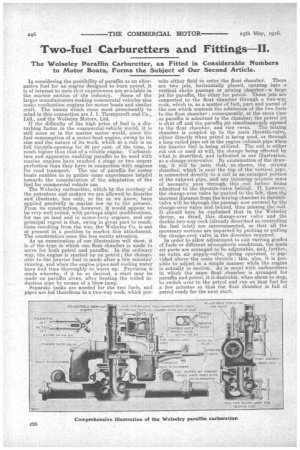Two-fuel Carburetters and Fittings—II.
Page 4

If you've noticed an error in this article please click here to report it so we can fix it.
The Wolseley Paraffin Carburetter, as Fitted in Considerable Numbers to Motor Boats, Forms the Subject of Our Second Article.
In considering the possibility of paraffin as an alternative fuel for an engine designed to burn petrol, it is of interest to note that experiences are available in the marine section of the industry. Some of the larger manufacturers making commercial vehicles also make combustion engines for motor boats and similar craft. The names which come most prominently to mind in this connection are J. I. Thornycroft and Co., Ltd., and the Wolseley Motors, Ltd.
If the difficulty of the high price of fuel is a disturbing factor in the commercial-vehicle world, it is still more so in the marine motor world, since the fuel consumption of a motor-boat engine, owing to its size and the nature of its work, which as a rule is on full throttle-opening for 95 per cent, of the time, is much higher than that of a vehicle engine. Carburetters and apparatus enabling paraffin to be used with marine engines have reached a stage or two nearer perfection than they have in connection with engines for road transport. The use of paraffin for motor boats enables us to gather some experiences helpful towards the consideration of the adaptation of the fuel for commercial vehicle use.
The Wolseley carburetter, which by the courtesy of the patentees and makers we are allowed to describe and illustrate, has only, so far as we know, been applied generally in marine use up to the present. From its construction, however, it would appear to be very well suited, with perhaps slight modificatibns, for use on land and in motor-lorry engines, and our principal regret is that, owing in great part to conditions resulting from the war, the Wolseley Co. is not at present in a position to market this attachment. The construction none the less merits attention.
As an examination of our illustration will show, it is of the type in which one float chamber is made to serve for both petrol and paraffin. In the ordinary way, the engine is started up on ,petrol ; the changeover to the heavier fuel is made after a few minutes' running, and when the engine pipes and cooling water have had time thoroughly to warm up. Provision is made whereb3r, if it be so desired, a start may be made on paraffin alone, after heating the coiled induction. pipe by means of a blow-lamp.
Separate tanks are needed for the two fuels, and pipes are led therefrom to a two-way cock, which per mits either fluid to enter the float chamber. There are two jets, horizontally placed, opening into a vertical choke passage or mixing chamber—a large jet for paraffin, the other for petrol. These jets are connected to the float chamber through a two-way cock, which is, as a matter of fact, part and paroel of the one which controls the admission of the two fuels to the float chamber ; consequently, at the same time as paraffin is admitted to the chamber; the petrol jet is shut off and the paraffin jet simultaneously opened. to the float chamber, and vice versa. The mixing chamber is coupled up to the main throttle-valve, either directly when petrol is being used, or through a long coiled pipe set in the engine exhaust pipe when the heavier fuel is being utilized. The coil is either cut out or used at will, the change being .effected by what is described, and indicated in our illustration, as a change-oveiavalve: By examination of the drawing, it will be seen that, as shown, the mixing chamber; which-is near the top of the vertical pipe, is connected directly to a coil in an enlarged portion of the exhaust pipe, and any incoming mixture must of necessity pass through this . coil before being admitted to the throttle-valve behind. If, however, the change-over valve be pushed to the, left, then tly41 shortest distance from the mixing chamber to throttlevalve will be through the passage now covered by the change-over valve and behind, thus missing the coil. It should here be explained that in the Wolseley device, as fitted, this change-over valve and the double two-way cock (already described as controlling the fuel inlet) are interconnected, so that all the necessary motions are imparted by pushing or pulling the change-over valve in the direction required. In. order to allow adjustment to suit varying gra,dea of fuels or different atmospheric conditions, the main air ports are arranged to be adjustable, and, further, an extra air supply-valve, spring operated, is previded above the main throttle ; this, also, it is possible to adjust in a simple manner while the engine is actually in motion. As is usual with carburetters in which the same float ,chamber is arranged for paraffin and petrol, it is desirable, when about to stop, to switch over to the petrol and run on that fuel for a few minutes so that the float chamber is full of petrol ready for the next start.




















